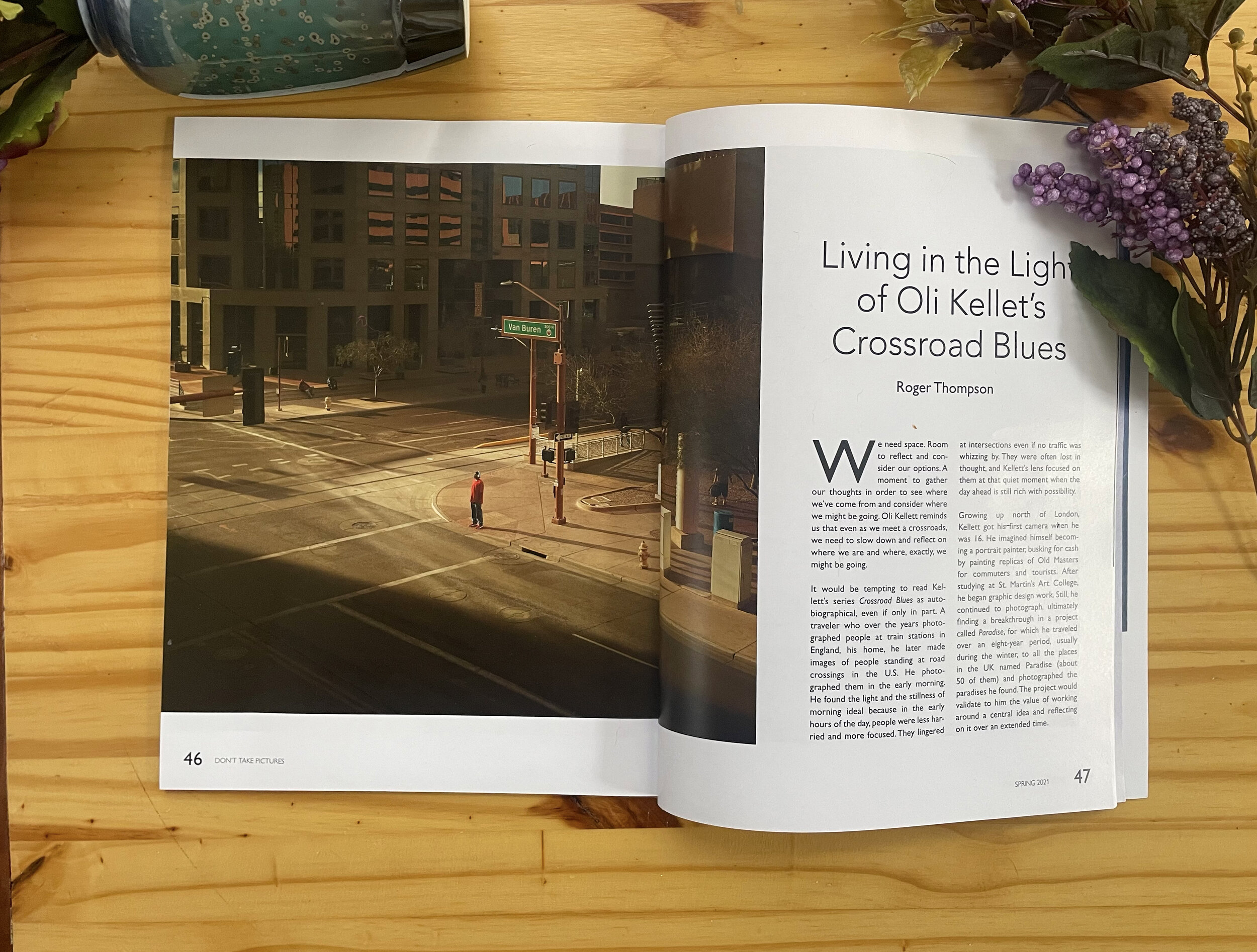We need space. Room to reflect and consider our options. A moment to gather our thoughts in order to see where we’ve come from and consider where we might be going. Oli Kellett reminds us that even as we meet a crossroads, we need to slow down and reflect on where we are and where, exactly, we might be going.
It would be tempting to read Kellett’s series Crossroad Blues as autobiographical, even if only in part. A traveler who over the years photographed people at train stations in England, his home, he later made images of people standing at road crossings in the U.S. He photographed them in the early morning. He found the light and the stillness of morning ideal because in the early hours of the day, people were less harried and more focused. They lingered at intersections even if no traffic was whizzing by. They were often lost in thought, and Kellett’s lens focused on them at that quiet moment when the day ahead is still rich with possibility.
Growing up north of London, Kellett got his first camera when he was 16. He imagined himself becoming a portrait painter, busking for cash by painting replicas of Old Masters for commuters and tourists. After studying at St. Martin’s Art College, he began graphic design work. Still, he continued to photograph, ultimately finding a breakthrough in a project called Paradise, for which he traveled over an eight-year period, usually during the winter, to all the places in the UK named Paradise (about 50 of them) and photographed the paradises he found. The project would validate to him the value of working around a central idea and reflecting on it over an extended time.
Figueroa St., LA, 2016
Crossroad Blues are images primarily from the U.S., reflecting a common theme in American artistic expression. Literary artists from Faulkner to Pynchon have used the crossroads as a trope, and writers in the Harlem Renaissance called on the theme to emphasize how crucial that moment was for African Americans as they sought to establish their own voices as significant to the American imagination. The notion of the crossroads in blues music—the most American of all music forms—is now irreversibly linked to Robert Johnson and the myth of the musician selling his soul to the devil in order to become a great artist. Kellett’s images are named for this tradition, but they seem to invert the devil-deals. They reflect settings that seem decidedly antagonistic to stillness—urban settings, where streets hum and professionals bustle. In Kellett’s images, though, normally busy streets are quiet and pedestrians are still, even meditative. Crosswalks reach out in front, behind, and alongside the figures in the photographs, and they linger in glowing morning light as though they are saints or are approaching an unseen altar.
“Figueroa St., LA, 2016” illustrates the meditative moment and stillness that Kellett wants us to consider. A lone figure stands in a streak of rich, orange light. At its edges, darkness crowds in, but in front of the figure, a crosswalk leads toward the source of the light. The figure is waiting. The street has no traffic, and no other people crowd into the space. Only the figure, the light, and the crosswalk—and the trembling possibility of the first step toward that light. The figure is upright, stock still. There is no certainty of forward movement. There is only the moment Kellett gives us, when the possibility of that first step is real, even if it’s not assured.
Hubbard St., Chicago, 2017
“Hubbard St., Chicago, 2017” converts that moment of lingering light into a moment of more levity, even play. A small group of kids and teens gather at a corner where dappled light reflected from windows illuminates their time together. One child swings around a street sign. The crosswalk is in the shadows, and as a woman in the background walks away down a sidewalk, the children linger, living in a brief, bright present, with no decision about their future necessary or even visible.
Kellett describes Crossroad Blues as exploring the idea of guidance. Where do we look when we are seeking our paths in life? Where do we stand and what light do we follow or walk away from? He wants us to experience a charged moment, and by printing the work in large scale, he attempts to immerse us into the scene. The goal of that immersion is not so much to make us a co-participant in the scene. It is not an invitation to walk into that place and feel it as the figures in front of us do. Instead, the immersion acts as a kind of mirror for our own inner worlds, where we see in Kellett’s images our own crossroads, our own destinations, and our own pathways, lit by early sun or cast in shadows of the turning world. Neither light nor shadow here is better or worse than the other. It’s the moment that counts. It’s the guidance we get simply from slowing down and seeing, regardless of where we might be going, what each moment offers us.
Stockton St., San Francisco, 2017
This article first appeared in Issue 16, The Blue Issue.


